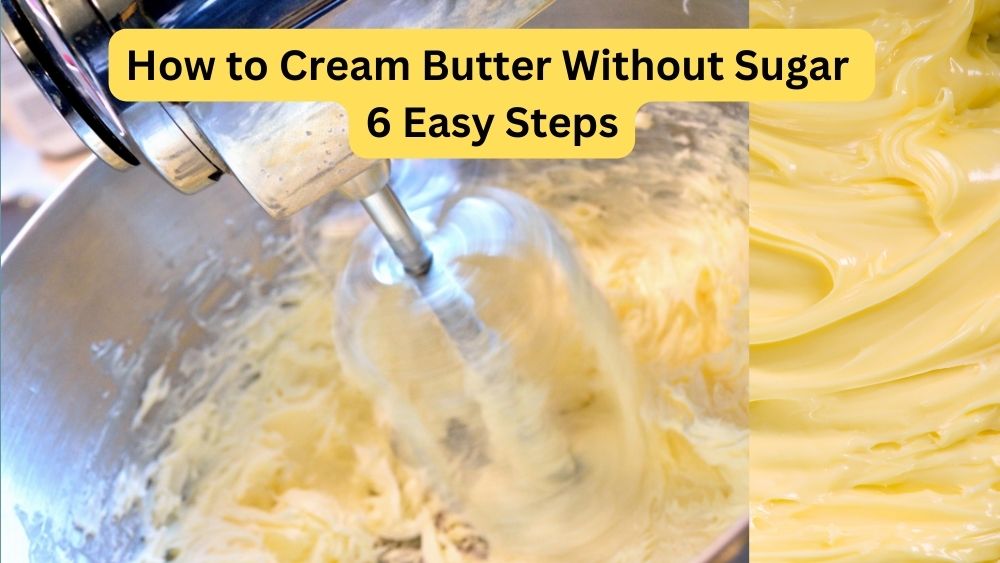To cream butter without sugar, bring your butter to room temperature so that is soft but not melted. Cut the butter into small pieces and place it into a mixing bowl. Using an electric mixer or a whisk, beat the butter until it is creamy and smooth. This will take around 2-3 minutes.
Remember, creaming butter without sugar is all about creating a smooth and creamy texture that will enhance the flavors of your savory or sweet dishes.

What Does Creaming Butter and Sugar Do?
When you cream both sugar and butter together, it creates tiny air pockets in the mixture so that the cookies or cake come out fluffy and airy. Without this step, your product can turn out dense and thin and even too large.
Both of these taste good, but the texture is somewhat different. Ideally, you’ll cream your butter and sugar with an electric beater or mixer, preferably either a hand mixture or a stand mixer using the paddle attachment. Beating it by hand with a wooden spoon is another alternative, but it can be painful and very time-consuming.
There are two ways to cream together butter and sugar. One involves creaming your butter on its own and then adding the sugar once that’s done. The second involves creaming the butter and sugar together, in one step instead of two.
In the end, both methods are effective and you should be happy with the way the product tastes once you take it out of the oven. Let’s take a look at the first method that creams butter on its own.
How to cream butter without sugar
Check out these easy steps to cream butter without sugar at home.
1. Start with Cold Butter
You can start with cold butter that you just took out of the refrigerator. Cut the butter into chunks and leave it out on the counter. To soften it quickly, heat a bowl of water in the microwave. Place the chopped butter cubes on a plate, pop it on top of the bowl and shut the microwave door. Leave it there for a few minutes and the heat will soften the butter.
Check the butter to see if it’s soft. Keep in mind it should be soft, not melted! If the butter isn’t soft at this point. Leave the butter over the hot water for another minute if it has not softened enough.
2. Set the Butter Out on the Counter
Butter needs to be softened before you cream it. Bringing it to room temperature is ideal which is around 60 degrees Fahrenheit before you do anything else with it. This will make it easier to cream and trap air bubbles.
3. Check the Butter to see if it’s Soft Enough
You can do this one of two ways. First, you can use a digital thermometer and make sure it is roughly 60 degrees. You can also press your finger into the butter and see if it makes an indentation.
If it does make one, and if it feels like a ripe peach, it’s ready to go. If it is shiny and squishy, put it into the refrigerator for five to ten minutes and let it get a little harder because this means it is actually too warm.
4. Consider Grating the Butter
If you’re in a hurry and don’t have time to let the butter get to room temperature, consider taking a cheese grater and grating it instead. This allows the butter to get softer much faster so you don’t have to wait as long to begin the next step of the process.
5. Choose the Right Bowl
You can cream the butter in any type of bowl, but keep in mind that the ceramic and stoneware bowls have rougher surfaces, which results in a much shorter creaming time because the butter “catches” on the bowls.
If you use bowls made out of plastic or metal, which are smooth, it will take you longer to cream the butter because it won’t “catch” on these bowls.
6. Decide How You’re Going to Cream the Butter
You can cream the butter one of two ways, described here:
By Hand
If you’re going to cream butter by hand, it’s best to use a wooden spoon, wire whisk, spatula, or even a fork. Once the mixture is free of lumps and very smooth, it means you can stop mixing. It is very difficult to over-mix when you’re creaming butter by hand, but you’ll want to make sure to mix well.
With a Mixer
Using either a stand mixer with the paddle attachment or a hand mixer, beat the butter on a low speed until it is smooth and creamy. Be careful not to under- or over-mix the butter and stop as soon as it is nice and creamy.
It is at this point that you’ll want to add the sugar and continue to beat the mixture until it is the right consistency. If you do not intend to add sugar, you can stop at this point and continue on to the next step in the recipe. This usually takes six to eight minutes, and you’ll notice that soft peaks have formed.
Summary
Beating butter and sugar together is the true definition of “creaming,” but you can cream butter alone if you like. Make sure the butter is at 60 degrees, is soft enough without being too soft, and that you thoroughly mix the butter either by hand or with a mixer.
I am an accredited practicing dietitian, experienced gardener and a dedicated cook. I love writing and sharing my experience so you can learn from my successes and mistakes.
